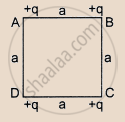Advertisements
Advertisements
Question
There is another useful system of units, besides the SI/mks A system, called the cgs (centimeter-gram-second) system. In this system Coloumb’s law is given by
F = `(Qq)/r^2 hatr`
where the distance r is measured in cm (= 10–2 m), F in dynes (= 10–5 N) and the charges in electrostatic units (es units), where 1 es unit of charge = `1/([3]) xx 10^-9 C`
The number [3] actually arises from the speed of light in vaccum which is now taken to be exactly given by c = 2.99792458 × 108 m/s. An approximate value of c then is c = [3] × 108 m/s.
(i) Show that the coloumb law in cgs units yields
1 esu of charge = 1 (dyne)1/2 cm.
Obtain the dimensions of units of charge in terms of mass M, length L and time T. Show that it is given in terms of fractional powers of M and L.
(ii) Write 1 esu of charge = x C, where x is a dimensionless number. Show that this gives
`1/(4pi ∈_0) = 10^-9/x^2 (N*m^2)/C^2`
With `x = 1/([3]) xx 10^-9`, we have `1/(4pi ∈_0) = [3]^2 xx 10^9 (Nm^2)/C^2`
or, `1/(4pi ∈_0) = (2.99792458)^2 xx 10^9 (Nm^2)/C^2` (exactly).
Solution
(i) F = `Q_q/r^2` = 1 dyne = `([1 "esu of charge"]^2)/[1 cm]^2`
Or, 1 esu of charge = 1 (dyne)1/2 (cm)
Hence, [1 esu of charge] = [F]1/2 L = [MLT–2]1/2 L = M1/2 L3/2 T–1
[1 esu of charge] = M1/2 L3/2 T–1
Thus charge in cgs unit is expressed as fractional powers (1/2) of M and (3/2) of L.
(ii) Consider the coloumb force on two charges, each of magnitude 1 esu of charge separated by a distance of 1 cm:
The force is then 1 dyne = 10–5N.
This situation is equivalent to two charges of magnitude x C separated by 10–2m.
This gives: F = `1/(4piε_0) * x^2/10^-4` which should be 1 dyne = 10–5 N.
Thus `1/(4 piε_0) * x^2/10^-4 = 10^-5` ⇒ `1/(4 piε_0) = 10^-9/x^2 (Nm^2)/C^2`
With `x = 1/([3] xx 10^9)`, this yields
`1/(4 piε_0) = 10^-9 xx [3]^2 xx 10^18 = [3]^2 xx 10^9 (Nm)^2/C^2`
With [3] → 2.99792458, we get
`1/(4 piε_0) = 8.98755.... xx 10^9 (Nm^2)/C^2` exactly
APPEARS IN
RELATED QUESTIONS
The electrostatic force on a small sphere of charge 0.4 μC due to another small sphere of charge − 0.8 μC in air is 0.2 N.
- What is the distance between the two spheres?
- What is the force on the second sphere due to the first?
- Two insulated charged copper spheres A and B have their centers separated by a distance of 50 cm. What is the mutual force of electrostatic repulsion if the charge on each is 6.5 × 10−7 C? The radii of A and B are negligible compared to the distance of separation.
- What is the force of repulsion if each sphere is charged double the above amount, and the distance between them is halved?
A charge of 1.0 C is placed at the top of your college building and another equal charge at the top of your house. Take the separation between the two charges to be 2.0 km. Find the force exerted by the charges on each other. How many times your weight is this force?
One end of a 10 cm long silk thread is fixed to a large vertical surface of a charged non-conducting plate and the other end is fastened to a small ball of mass 10 g and a charge of 4.0× 10-6 C. In equilibrium, the thread makes an angle of 60° with the vertical. Find the surface charge density on the plate.
Two charges 2.0 × 10−6 C and 1.0 × 10−6 C are placed at a separation of 10 cm. Where should a third charge be placed, such that it experiences no net force due to these charges?
Two identical particles, each with a charge of 2.0 × 10−4 C and mass of 10 g, are kept at a separation of 10 cm and then released. What would be the speed of the particles when the separation becomes large?
A force F acts between sodium and chlorine ions of salt (sodium chloride) when put 1 cm apart in air. The permittivity of air and dielectric constant of water are `epsilon_0` and K respectively. When a piece of salt is put in water, electrical force acting between sodium and chlorine ions 1 cm apart is ____________.
For charges q1 and q2 separated by a distance R the magnitude of the electrostatic force is given by ______.
Four equal charges q are placed at the four comers A, B, C, D of a square of length a. The magnitude of the force on the charge at B will be ______.

